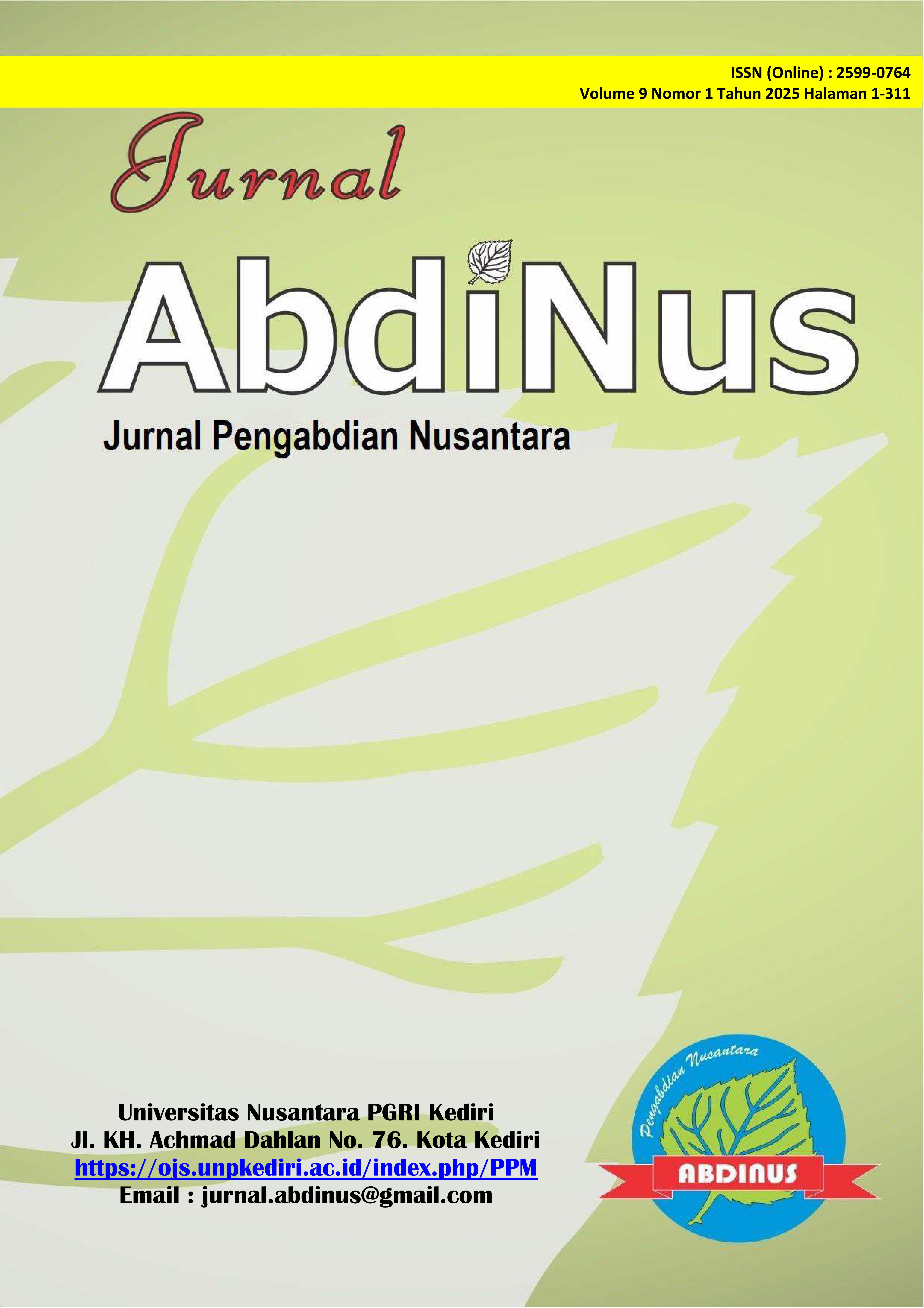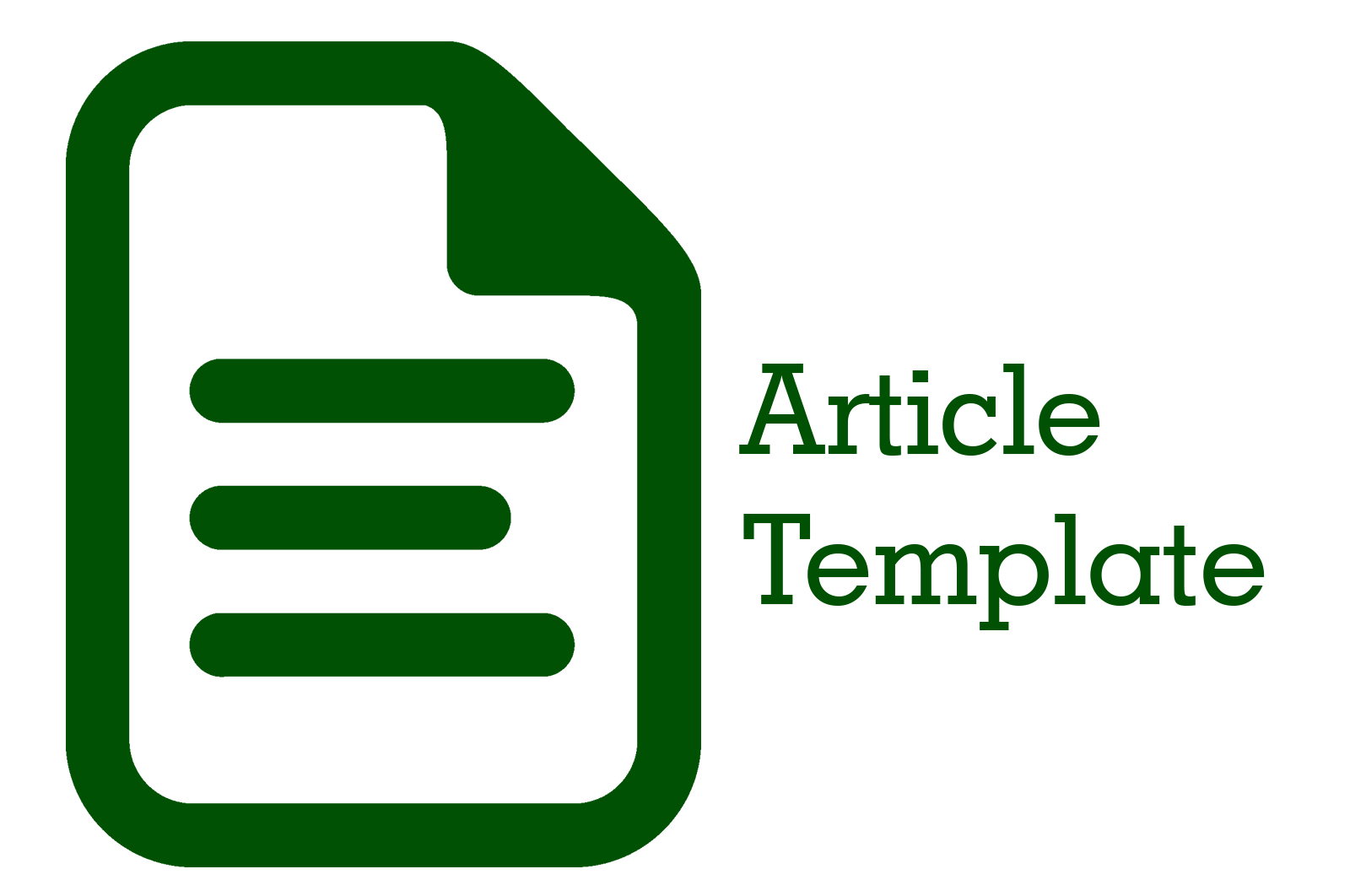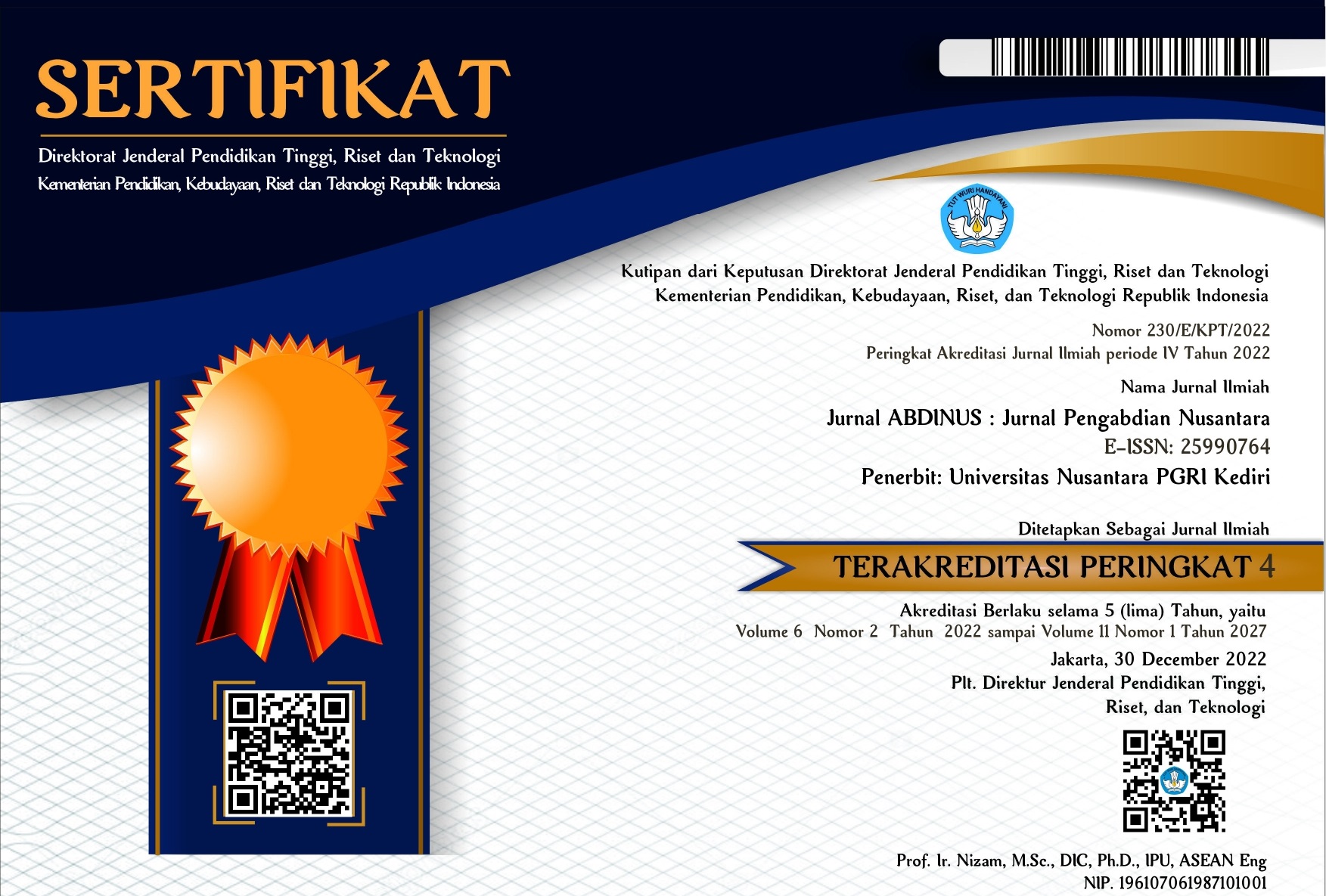Peningkatan Keberdayaan Ekonomi Melalui Pengelolaan Limbah Organik dan Pertanian Terpadu di Lahan Terbatas
DOI:
https://doi.org/10.29407/ja.v9i1.23707Keywords:
Organic waste, Integrated farming, Aerofarming, Budikdamber, Product marketingAbstract
Agricultural practices on limited land using organic waste management byproducts pose a significant challenge, especially in Lempake Village, North Samarinda. Bank Ramli Bukit Benanga in RT 037 Bukit Benanga Housing has successfully converted organic waste into eco enzyme, compost, and maggot, though these products have not been optimally utilized or marketed. This Community Partnership Program aims to empower the community by enhancing skills in integrated agriculture on limited land and facilitating the marketing of organic products from constrained spaces. Through training and mentoring in aerofarming, tabulampot, and budikdamber techniques, the program aims to utilize eco enzyme, compost, and maggot more effectively in plant and fish cultivation. It also equips partners with packaging design skills and strategies for online and offline marketing. The program results include increased independent food production, enhanced partner income through organic product marketing, and improved environmental quality around Bukit Benanga Housing. Additionally, the program supports the Sustainable Development Goals (SDGs), particularly in poverty reduction, welfare improvement, and sustainable production and consumption patterns.
Downloads
References
Afnur, E. S., Istiqomah, I., Isnansetyo, A., Murwantoko, & Sukardi. (2023). Ammonium removal characteristics of facultative heterotrophic nitrifying bacteria isolated from shortfin eel ( Anguilla bicolor) recirculation aquaculture system. IOP Conference Series: Earth and Environmental Science, 1260(1). https://doi.org/10.1088/1755-1315/1260/1/012047
Ahmed, N., Zhang, B., Deng, L., Bozdar, B., Li, J., Chachar, S., Chachar, Z., Jahan, I., Talpur, A., Gishkori, M. S., Hayat, F., & Tu, P. (2024). Advancing horizons in vegetable cultivation: a journey from ageold practices to high-tech greenhouse cultivation a review. Frontiers in Plant Science, 15. https://doi.org/10.3389/fpls.2024.1357153
Akumuntu, A., Hong, J.-K., Jho, E. H., Omidoyin, K. C., Park, S.-J., Zhang, Q., & Zhao, X. (2024). Biochar derived from rice husk: Impact on soil enzyme and microbial dynamics, lettuce growth, and toxicity. Chemosphere, 349, 140868. https://doi.org/10.1016/j.chemosphere.2023.140868
Amaya, N. L. R., Cobeña, L. S. A., Gualpa, T. L. A., Ochoa, A. D. F., & Suarez, C. B. F. (2022). Manufacture of humus from plant residues. International Journal of Life Sciences, 6(1), 10–18. https://doi.org/10.53730/ijls.v6n1.4739
Anshori, A., Suswatiningsih, T. E., Al Viandari, N., Mujiyo, M., Purwaningsih, H., Budiarti, S. W., Pustika, A. B., & Cahyaningrum, H. (2023). Ameliorant of rice husk charcoal supports rice cultivation in dry land. IOP Conference Series: Earth and Environmental Science, 1168(1). https://doi.org/10.1088/1755-1315/1168/1/012007
Armanda, D. T., Guinée, J. B., & Tukker, A. (2019). The second green revolution: Innovative urban agriculture’s contribution to food security and sustainability – A review. In Global Food Security (Vol. 22, pp. 13–24). Elsevier B.V. https://doi.org/10.1016/j.gfs.2019.08.002
Aufa Ain, A. S., & Noraini, M. J. (2023). Effects of rice husk biochar (RHB) with combined inoculation of arbuscular mycorrhizal fungi (AMF) and phosphate solubilizing bacteria (PSB) on growth of maize (Zea mays). IOP Conference Series: Earth and Environmental Science, 1131(1). https://doi.org/10.1088/1755-1315/1131/1/012007
Cerozi, B. S., Arlotta, C. G., & Richardson, M. L. (2022). Fish Effluent as a source of water and nutrients for sustainable urban agriculture. Agriculture (Switzerland), 12(12). https://doi.org/10.3390/agriculture12121975
Chaudhry, A. R., & Mishra, V. P. (2019). A Comparative Analysis of Vertical Agriculture Systems in Residential Apartments. 2019 Advances in Science and Engineering Technology International Conferences (ASET), 1–5. https://doi.org/10.1109/ICASET.2019.8714358
Despommier, D. D. (2011). The vertical farm: Feeding the world in the 21st century. Picador.
Ehrlich, P. R. , H. J. , & H. M. A. (2020). Ecological and Practical Applications for Sustainable Agriculture (K. Bauddh, S. Kumar, R. P. Singh, & J. Korstad, Eds.). Springer Singapore. https://doi.org/10.1007/978-981-15-3372-3
Fitriani, Helmi Haris, & Rih Laksmi Utpalasari. (2023). Pemanfaatan maggot (Hermetia illucens) sebagai pakan alternatif dengan kombinasi pakan pelet terhadap pertumbuhan dan sintasan ikan gabus (Channa striata). Jurnal Indobiosains, 5(1), 13–24. https://doi.org/10.31851/indobiosains.v5i1.10108
Gunawan, I., & Ahmadi, H. (2024). Kajian Dan Rancang Bangun Alat Pakan Ikan Otomatis (Smart Feeder) Pada Kolam Budidaya Ikan Berbasis Internet Of Things. Jurnal Informatika Dan Teknologi, 7(1), 40. https://doi.org/10.29408/jit.v7i1.23523
Harianti, R., Mianna, R., & Hasrianto, N. (2023). Budidaya ikan dalam ember (Budikdamber) dengan konsep Yumina di Kelurahan Maharatu, Marpoyan Damai. To Maega : Jurnal Pengabdian Masyarakat, 6(1), 44. https://doi.org/10.35914/tomaega.v6i1.1282
Haripriadi, B. D. (2023). Penerapan mesin pengolahan kotoran ternak sapi sebagai pupuk kandang pada kelompok ternak sapi “Ndesi” di desa Pedekik. Tanjak: Jurnal Pengabdian Kepada Masyarakat, 4(1). https://doi.org/10.35314/tanjak.v4i1.3643
Ipanna Enggar Susetya, & Zulham Apandy Harahap. (2016). Aplikasi budikdamber (budidaya ikan dalam ember) untuk keterbatasan lahan budidaya di kota Medan. Abdimas Talenta, 3(2), 416–420. https://talenta.usu.ac.id/abdimas/article/view/4165
Kimera, F., Mugwanya, M., Dawood, M., & Sewilam, H. (2023). Growth response of kale (Brassica oleracea) and Nile tilapia (Oreochromis niloticus) under saline aqua-sandponics-vegeculture system. Scientific Reports, 13(1). https://doi.org/10.1038/s41598-023-29509-9
Nadiro, V. N., Andayani, S., Widodo, M. S., & Nurhalisa, N. (2023). Different stocking density on water quality of Red tilapia (Oreochormis sp) in budikdamber system. Jurnal Penelitian Pendidikan IPA, 9(4), 2030–2035. https://doi.org/10.29303/jppipa.v9i4.3236
Nguyen, T. T., Sasaki, Y., Nasukawa, H., & Katahira, M. (2024). Recycling potassium from cow manure compost can replace potassium fertilizers in paddy rice production systems. Science of The Total Environment, 912, 168823. https://doi.org/10.1016/j.scitotenv.2023.168823
R., S., T., J., Sweatha, S. M., M., S., A., G., & Balakrishna, M. (2014). Coco peat - An alternative artificial soil ingredient for the earthworm toxicity testing. Journal of Toxicology and Environmental Health Sciences, 6(1), 5–12. https://doi.org/10.5897/jtehs2013.0289
Reinders, F. B. (2011). Irrigation methods for efficient water application: 40 years of South African research excellence. Water SA, 37(5), https://doi.org/10.4314/wsa.v37i5.13
Ronny Nangoi, Rena Paputungan, Tommy B. Ogie, Rafli I. Kawulusan, Rinny Mamarimbing, & Frangky J. Paat. (2022). Utilization of household organic waste as an eco enzyme for the growth and product of cultivate culture (Lactuca sativa L.). Jurnal Agroteknologi Terapan, 3(2), 422–428. https://doi.org/10.35791/jat.v3i2.44862
Sunarti Pantang, L., & Ardan, A. S. (2021). Efektivitas pupuk organik cair limbah rumah tangga dalam meningkatkan pertumbuhan dan produksi tanaman tomat (Lycopersicum esculentum Mill.). EduBiologia, 1(2), 85–90. http://dx.doi.org/10.30998/edubiologia.v1i2.8966
Suntoro, Herdiansyah, G., Widijanto, H., Tjahjanto, A. D., Puspitasari, C., & Wardhana, H. R. (2024). Effect of green manure on the availability of Phosphorus and Potassium nutrients in Vertisols. IOP Conference Series: Earth and Environmental Science, 1362(1). https://doi.org/10.1088/1755-1315/1362/1/012045
Suryadi, K., & Supriyo, E. (2021). Uji efektivitas produksi pupuk cair dari limbah / sampah organik rumah tangga. Jurnal Keteknikan Pertanian Tropis Dan Biosistem, 9(3), 202–207. https://doi.org/10.21776/ub.jkptb.2021.009.03.01
Terry Pakki, Robiatul Adawiyah, Agung Yuswana, Namriah, Muhammad Arief Dirgantoro, & Agustono Slamet. (2021). Pemanfaatan ecoenzyme berbahan dasar sisa bahan organik rumah tangga dalam budidaya tanaman sayuran di pekarangan. Prosiding PEPADU, https://jurnal.lppm.unram.ac.id/index.php/prosidingpepadu/article/view/385
Vikram, N., Sagar, A., Gangwar, C., Husain, R., & Narayan Kewat, R. (2022). Properties of Humic Acid Substances and Their Effect in Soil Quality and Plant Health. In Humus and Humic Substances - Recent Advances. https://doi.org/10.5772/intechopen.105803
Walianggen, A., & Yasanto, P. (2022). Biochar Rice Husk Charcoal on Growth and Production of Long Bean Plants (Vigna sinensis L.): Formulation Analysis. 2(1), 1–6. https://doi.org/10.32764/agaricus.v2i1.2768.















